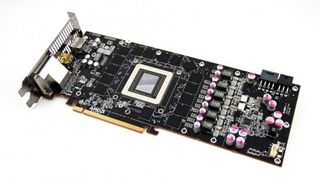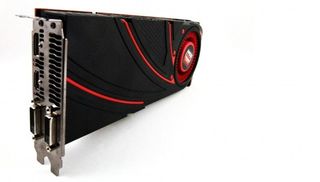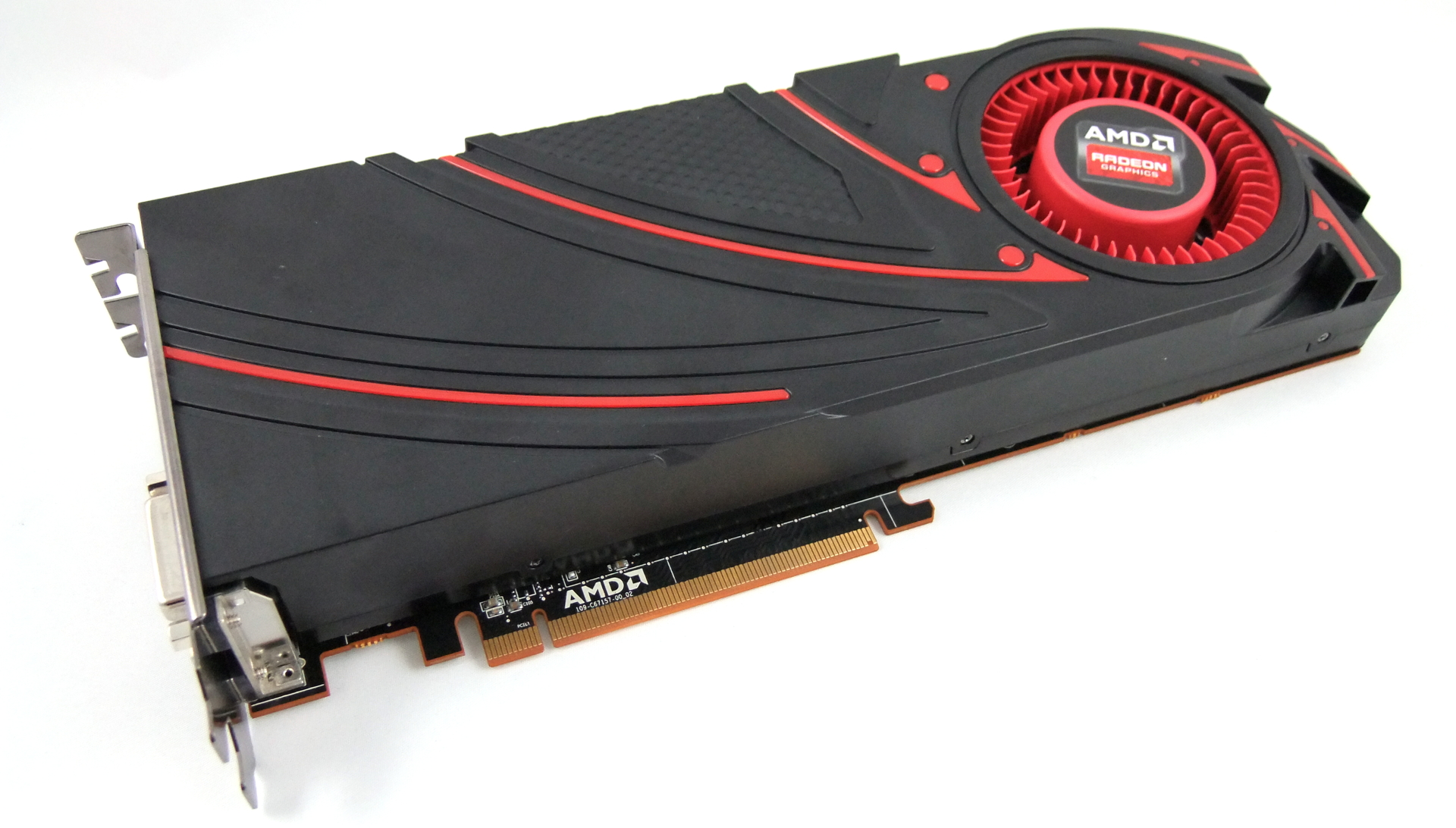Our Verdict
A top quality card which, at its best, will take on any stock GPU and come out on top.
PC Gamer's got your back
Look. It's new. Like actually new, not just old but with a new sticker. Not necessarily new technology, but y'know, a genuine new configuration. Yup, the AMD Radeon R9 290X is the first actually new graphics card they have released in an absolute age. Sure, we've seen the R9 280X (actually a HD 7970 GHz), the R9 270X (actually a HD 7870) and the R7 260X (actually a HD 7790), but this is a card with a bona fide new GPU.
The Radeon R9 290X is AMD's latest flagship graphics card aimed squarely at taking on the top-end of Nvidia's rivalling graphics lineup. And the scary thing? It manages it.
By 'top-end' I'm including the ultra-enthusiast class GeForce GTX Titan in that along with the GeForce GTX 780. The fact AMD's latest card can be mentioned in the same breath as the Nvidia's Titan is testament to how well AMD have engineered the Hawaii XT GPU sat inside the R9 290X. So what's in this brand new GPU? Well, as I said earlier, it's not really new technology , but the Graphics Core Next (GCN) architecture has proved pretty powerful over the last few generations so it's no surprise to see the Hawaii XT still rocking the same Radeon cores, only this time we're looking at some 2,816 of them, as opposed to the 2,048 cores of the R9 280X/HD7970.
That makes it a rather hefty chunk of silicon. It comes in at somewhere around 435mm2 in terms of die size, and packs in over six billion transistors. Along with this new GPU we've also got a broad 512-bit memory bus, helping shunt data in and out of the 4GB GDDR5 framebuffer.
Hot stuff
Because of the size and power of this new GPU though we are talking about one very hot and very power-hungry chip. AMD have been very keen to point out that the 95ºC operating temperature of the Hawaii GPU is perfectly normal, and presents no tangible risk to the working life of the chip.

I was told “95ºC is a perfectly safe temperature at which the GPU can operate for its entire life. There is no technical reason to reduce the target temperature below 95ºC.” That does make for a very hot environment for the rest of your PC components however.
AMD's newest card uses dynamic clockspeed to tune the chip frequency and voltage depending on the temperature of the GPU itself. When you point it at 95ºC you'll get the most out of the chip. That does, however, make it rather loud. Even with the fanspeed limited to 55% in the default mode it sounds like you're standing in a wind tunnel once you crank up the GPU load. At 100% the fans are deafening. You can though opt to boot your Radeon R9 290X in 'Quiet mode' as opposed to the louder 'Über mode'.
'Quiet mode' knocks the maximum fanspeed down to just 40% and that makes for a much more pleasant-sounding gaming environment. You will have to sacrifice some clockspeed for that - in my tests I was seeing the Hawaii XT chip hit a maximum of around 850MHz as opposed to the 1GHz the 'Über mode' nets you.
Power play
So, it's super-loud and super-hot. That doesn't sound like a recipe for a world-beating GPU, but the R9 290X delivers some serious performance. If the current pricing of $550 / £450 sticks around after launch today then you're looking at a card that's almost half the price of a GTX Titan and almost always has it beat.
In my graphics benchmarks, with the Titan at stock speeds and the R9 290X in 'Über mode', the Radeon card wins four out of the six tests. That's pretty convincing, especially when you take into account the wins in the minimum frame rates too.
I'm still reticent to give the R9 290X the nod as the outright fastest single-GPU graphics card around however. To me it seems like AMD's Radeon R9 290X is running close to the ragged edge in terms of performance - I doubt we're going to see a lot else out of it given the heat and power draw at reference clocks. Nvidia's GTX Titan, however, still has a lot of overclocking overhead if you want to take advantage of it.
That's moot when you consider the price gap between the two. The AMD Radeon R9 290X is the fastest single-GPU graphics card any sane person would buy. The poor GTX 780, at the moment, is some £50 more expensive and consistently performs slower in every test you care to mention.

It's a win for AMD then, and a quite convincing one if I'm honest. Personally, the heat and noise would give me pause for thought - and it's definitely not a card I'd recommend for any lounge-based Steam Machine for the aural assault alone. If you're talking pure gaming performance, the R9 290X is the current graphics card king. Now the pressure's on the Nvidia GeForce GTX 780 Ti and also the incoming R9 290 without the X to raise the bar. Nvidia will be desperate to dethrone this new graphics card and, will at this moment, be testing and tweaking their new silicon to beat it.
Benchmarks
All graphics tests were carried out using the latest drivers releases on the same Intel i7-4770K / Z87 test system. Because of the high-end nature of the cards involved all the benchmarks noted here were run at 2560 x 1600 with 4x anti-aliasing and the highest settings available. The initial figures are the average frame rate and the figures in parentheses are the minimum frame rates in the test.
If you guys want me to post the 1080p performance pipe up and I'll update the review with them.
DirectX 11 tessellation performance
Heaven 4.0 – FPS: higher is better
AMD R9-290X 'Über' – 33.7 (17.4)
AMD R9-290X 'Quiet' – 31.8 (16.4)
Nvidia GTX Titan – 37 (18.2)
Nvidia GTX 780 – 33.2 (16)
DirectX 11 gaming performance
Bioshock Infinite – FPS: higher is better
AMD R9-290X 'Über' – 57 (16)
AMD R9-290X 'Quiet' – 56 (16)
Nvidia GTX Titan – 60 (11)
Nvidia GTX 780 – 56 (11)
Company of Heroes 2 – FPS: higher is better
AMD R9-290X 'Über' – 29 (15)
AMD R9-290X 'Quiet' – 29 (15)
Nvidia GTX Titan – 25 (12)
Nvidia GTX 780 – 22 (11)
GRID 2 – FPS: higher is better
AMD R9-290X 'Über' – 86 (68)
AMD R9-290X 'Quiet' – 75 (61)
Nvidia GTX Titan – 77 (61)
Nvidia GTX 780 – 70 (50)
Total War: Rome II – FPS: higher is better
AMD R9-290X 'Über' – 36 (13)
AMD R9-290X 'Quiet' – 32 (14)
Nvidia GTX Titan – 33 (12)
Nvidia GTX 780 – 30 (9)
Metro Last Light – FPS: higher is better
AMD R9-290X 'Über' – 26 (13)
AMD R9-290X 'Quiet' – 23 (13)
Nvidia GTX Titan – 24 (13)
Nvidia GTX 780 – 23 (13)
Peak temperature performance
100% GPU load – ºC: cooler is better
AMD R9-290X 'Über' – 95
AMD R9-290X 'Quiet' – 95
Nvidia GTX Titan – 80
Nvidia GTX 780 – 80
Peak platform power performance
GRID 2 – Watts: lower is better
AMD R9-290X 'Über' – 383
AMD R9-290X 'Quiet' – 313
Nvidia GTX Titan – 300
Nvidia GTX 780 - 283
*** UPDATE ***
The 1080p gaming performance of the Radeon R9 290X does make for slightly better reading for Nvidia with the GTX Titan winning three out of the five tests. But only by a small amount. These high-end cards aren't really designed for 1080p gaming - anyone spending nigh-on £500 on a graphics card with only a 1920x1080 screen I'd definitely recommend upgrading that next.
DirectX 11 1080p gaming performance
Bioshock Infinite – FPS: higher is better
AMD R9-290X 'Über' – 93 (18)
AMD R9-290X 'Quiet' – 91 (17)
Nvidia GTX Titan – 100 (11)
Nvidia GTX 780 – 92 (10)
Company of Heroes 2 – FPS: higher is better
AMD R9-290X 'Über' – 48 (26)
AMD R9-290X 'Quiet' – 48 (26)
Nvidia GTX Titan – 42 (21)
Nvidia GTX 780 – 38 (19)
GRID 2 – FPS: higher is better
AMD R9-290X 'Über' – 108 (84)
AMD R9-290X 'Quiet' – 105 (82)
Nvidia GTX Titan – 109 (90)
Nvidia GTX 780 – 105 (87)
Total War: Rome II – FPS: higher is better
AMD R9-290X 'Über' – 48 (11)
AMD R9-290X 'Quiet' – 45 (9)
Nvidia GTX Titan – 49 (25)
Nvidia GTX 780 – 46 (20
Metro Last Light – FPS: higher is better
AMD R9-290X 'Über' – 47 (14)
AMD R9-290X 'Quiet' – 43 (16)
Nvidia GTX Titan – 42 (20
Nvidia GTX 780 – 39 (20)
A top quality card which, at its best, will take on any stock GPU and come out on top.

Dave has been gaming since the days of Zaxxon and Lady Bug on the Colecovision, and code books for the Commodore Vic 20 (Death Race 2000!). He built his first gaming PC at the tender age of 16, and finally finished bug-fixing the Cyrix-based system around a year later. When he dropped it out of the window. He first started writing for Official PlayStation Magazine and Xbox World many decades ago, then moved onto PC Format full-time, then PC Gamer, TechRadar, and T3 among others. Now he's back, writing about the nightmarish graphics card market, CPUs with more cores than sense, gaming laptops hotter than the sun, and SSDs more capacious than a Cybertruck.
